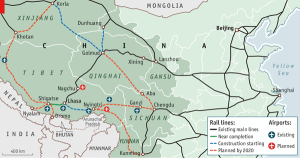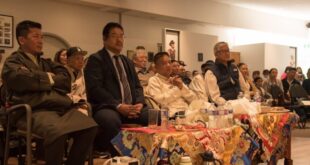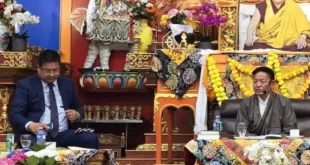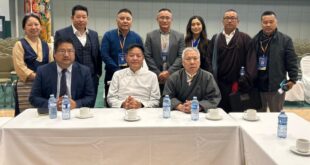The Economist (Print Edition)
June 21, 2014
http://www.economist.com/news/china/21604594-communist-party-deepens-tibets-integration-rest-country-taming-west
WHEN it opened eight years ago, the railway from Golmud to Lhasa was one of the most ambitious rail ventures ever attempted. At a cost of $4 billion, tracks were built across 550km (340 miles) of permafrost, reaching an altitude of 5,000 metres (16,400 feet)—the highest railway in the world. This September, an extension of the line will open from Lhasa to Shigatse, the first part of a further plan to knit Tibet into the rest of China.
The line to Shigatse stretches 250km southwest of Lhasa and will reduce the five-hour road journey to two hours by rail. As well as allowing easier access for tourists to Tibet’s second city, it will make an area rich in natural resources more accessible. (The Chinese name for Tibet, Xizang, translates as “Western treasurehouse”.) In the autumn the construction is due to start on another extension, running 400km from Lhasa to Nyingtri, a county with large hydropower potential.
By 2020 the aim is to complete several other major rail routes connecting Tibet with its neighbouring provinces of Xinjiang, Sichuan and Yunnan (see map). One of them, a 1,900km railway from Lhasa to Chengdu, will cost more than $20 billion.
 Two more railways from Shigatse to the Nepalese and Indian borders, at Nyalam and Dromo, are also planned, to the alarm of the Indian government, which last week announced plans to fortify 54 new border posts in Arunachal Pradesh, a north-eastern state that China invaded in 1962.
Two more railways from Shigatse to the Nepalese and Indian borders, at Nyalam and Dromo, are also planned, to the alarm of the Indian government, which last week announced plans to fortify 54 new border posts in Arunachal Pradesh, a north-eastern state that China invaded in 1962.
The party’s infrastructure drive is an important part of its policy of integrating the poorer west of the country with the richer east. In Xinjiang, in the far north-west, where many members of the ethnic Uighur minority chafe at rule from Beijing, building transport links is also seen as a way to increase national security. Lavish spending on infrastructure reflects the central government’s determination to use economic development to pacify restive western regions. The sheer scale of such initiatives, in Xinjiang and Tibet, has its costs. “The people pushing these policies can’t really see the ‘smaller’ issues of preserving culture and the environment,” says Robert Barnett, a professor of modern Tibetan studies at Columbia University. “It is like using a bulldozer to herd mice.”
Few outside China believe such policies are working, especially after unrest spread across the Tibetan plateau in 2008. Through religious control, the erosion of Tibetan language, intense surveillance and “patriotic education” policies the government has sought to suppress traditional beliefs and customs. More than 130 Tibetans have set fire to themselves in protest since 2009. It has become almost impossible for ordinary Tibetans to travel abroad from Tibet, and border security has been tightened. Before 2008 the number of Tibetans escaping into Nepal each year was as high as 3,000. Last year only 300 made it out.
Meanwhile the number of ethnic-Han Chinese coming to Tibet as tourists or workers continues to soar. Last year 7.5m passengers rode the railway from Golmud to Lhasa—more than double the population of Tibet itself. Improved access to previously remote parts will increase the volume of visitors, drawn by the promise of an unspoiled and spiritually rich land. But it is a land that is being transformed.
As the train descends towards Lhasa, the scenery outside the window changes. Across the grasslands appear the wide chimneys of a refinery and other signs of industrialisation. The industrial development of Tibet has lagged far behind China’s central and eastern provinces. Now the party has the technical know-how and financial reserves to build on Tibet’s difficult terrain. If all goes to plan the extraction of natural resources will generate economic growth. The party values Tibet’s mineral reserves at 600 billion yuan ($96 billion). One mine in Shethongmon county, near Shigatse, is expected to produce 116m pounds (53m kg) of copper, 190,000 ounces of gold and 2.4m ounces of silver annually. Mining could make up a third of the region’s GDP.
Trickle down
That would imply a dramatic restructuring of the economy, which for decades has been sustained by government subsidies and state-led investment. Last year the region’s GDP grew by nearly 13%. Chinese companies and workers wield advantages: Tibetans often lack the linguistic skill and the connections to get ahead. As a result, much revenue flows back east. However, some of the gains are now starting to trickle down to ordinary Tibetans. The annual income of even those in the poorest rural regions is rising. Roads and railways are making consumer goods more available. Certain social schemes, too, are aimed at making people’s lives more comfortable. The government says one mass relocation project, completed last year, has moved 2.3m people into houses. The problem was that many of them were farmers, who did not want to move.
As well as railways, there are now six airports on the Tibetan plateau. Four of them have opened or expanded since 2010 and there are plans for two more. New airports near the southern border have irked neighbours. One security adviser to India’s government noted Beijing’s “more assertive policy” on territorial issues.
Meanwhile incentive schemes and government grants continue to draw more Han migrant workers. The railway facilitates the flow. Mr Zhao, a portly 32-year-old builder from Lanzhou, first came to Tibet in 2006. He says at first, as a Han Chinese, he felt unwelcome in Lhasa. Local Tibetans would sometimes steal his company’s sand. One day Mr Zhao hopes to return to Lanzhou permanently. But for the moment, in Tibet, there are roads and railways to build.



